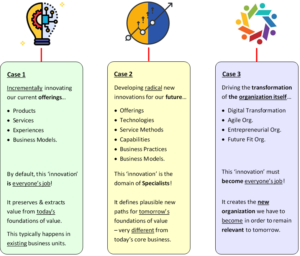Let’s Settle the Debate – Innovation Both Is & Is Not Everyone’s Job

Archive image courtesy of My Starbucks Idea – ideas.starbucks.com.
The Debate
There’s an insidious debate that’s bounced around for probably the better part of twenty years now. It’s the debate of whether or not ‘innovation is everyone’s job’.
Some think that ‘innovation is everyone’s job’ because we have to bring the entire organization into the grand practice of innovation and engage them in finding new opportunities to pursue, and innovative new solutions for those opportunities. Plus, doing so helps to spark even more innovative thinking in their day-to-day work and thereby inherently embeds ‘innovation’ into the organization. Also, if we isolate innovation from the heart of the organization, then how is the organization itself ever going to adapt and change to a new world.
Point taken.
Others think that ‘innovation is not everyone’s job’ because the vast majority of organizations are already so busy trying to run their day-to-day operations that there’s very little time, energy, and interest left over for pursuing any real ‘innovation’. This is a fact that’s painfully evident in very traditional businesses operating in slow-moving industries. And so consequently there’s the need for a separate innovation unit to own and drive truly meaningful innovation on behalf of the organization, since having such a unit is the only way that innovation will ever actually happen at the organization; otherwise it simply won’t happen.
Point taken.
Unfortunately, both are gross over simplifications.
The Truth Lies In Context
The truth is… both of these arguments are correct, but neither one alone addresses the entirety of the issue. Part of the problem lies in our use of the word ‘innovation’ itself. So, to make this more clear, we have to understand that ‘innovation’ is largely manifested in one of two domains – either in:
- What we offer to our marketplace… our products, services, experiences, and so on – as well as the business models we use to do so – all of which are fodder for new ‘innovation’.
- Our business organization itself… how it operates and engages the world around it – all of which is fodder for ongoing transformation and reinvention.
The first of these is about renewal – constantly renewing the foundations of value that we offer to the marketplace. Some aspects of this are easy, while other aspects are hard. This is why it has so many moving parts, each of which has to be addressed in its own way.
The second of these is about reinvention – constantly evolving and transforming the organization itself to remain relevant to the world around it, and resilient to the changes before it. This could be through digital transformation, radical new business models, abandoning waning technologies (even if they are our current ‘bread & butter’), and embracing emerging new technologies and practices (even when doing so means a steep learning curve for us, not to mention a brand new fight for dominance).
Both of these fall under that grand umbrella of ‘innovation’ – clearly now an overly broad term.
The Answer To This Debate
And so the real answer to this debate is that ‘innovation’ (in this broadest sense) is in fact everyone’s job, but… certain parts of it have to be handled by Specialists focused exclusively on it.
More specifically what this looks like is a trifurcated ‘sandwich’ model in which ‘innovation is everyone’s job’ happens out along the outsides at either end, and ‘innovation is not everyone’s job’ happens in the very center.
Figure 1 illustrates this.

Figure 1: The three cases of ‘innovation’ in the organization – and in each case ‘Who’s job it is.’
Case 1
On the left side (Case 1), we have the entire organization engaged in ‘innovation’, but in this case the ‘innovation’ they are working on and delivering is all characteristically incremental innovation. These represent the ongoing evolution of their current offerings (products, services, experiences, etc.). This is all about the first type of ‘innovation’ above – innovating our offerings, and only in an incremental manner. This fits with the ongoing operational charters of most organizations’ existing business units.
This being said however, it does remain true that from a cultural standpoint, everyone in the organization should see themselves as being responsible for innovation, whether in this vein of work or in contributing otherwise. If they don’t, then very few real innovation efforts will get the support they need to succeed. Indeed, who can argue with Albert Einstein when he said, “Innovation is everyone’s responsibility, not just R&D’s.â€Â So from a cultural, engagement, and support standpoint, he was absolutely correct.
It also remains true that any one of these individuals may be the one who recognizes the next great new opportunity for the organization – long before anyone else does – and subsequently puts forth the next great idea for the organization to pursue. This is why we should never stop running campaigns to identify these, nor promoting an environment that nurtures them. But just because a particular individual was the one who recognized and articulated a specific new opportunity does not inherently mean they are the one who should develop the right solution for that opportunity. They may or may not be. If they are, then they will very likely not be able to do so in their current job setting; they will need to go somewhere else in the organization to do so – somewhere with the right conditions to properly incubate the new idea.
All of which brings us to Case 2.
Case 2
In the center (Case 2), we have a specialist Innovation Unit operating independently of the organization. This is our quintessential ‘Advanced Innovation Group’ or ‘Core Innovation Group’ operating inside their own cloistered Innovation Space.
Yet their charter and task is very different from that of the rest of the organization. They are taking on the far more advanced, longer-term radical innovations that do not fit nicely inside the organization’s existing business units, and with what those units are doing. In fact, some of them may even be an existential threat to those units. These are the very far-reaching advanced innovations and R&D projects that seek to produce ‘tomorrow’s foundations of value’ – breakthrough, disruptive, and transformative innovations that go well beyond the core of today’s organization and pave the way for who and what the organization must be and do tomorrow. It’s the Nike Innovation Kitchen developing FlyKnit Fabric; the Corning Center of Excellence developing the next generation of Gorilla Glass; and Google X (Google’s ‘Moonshot Factory’) developing self-driving cars (which went on to become Waymo).
These are the modern-day equivalents of the industrial-era R&D lab, except that today we are far savvier and more sophisticated about what we develop and how we develop it, using market testing early on with MVPs and validated learning cycles – the Lean Startup Method – to avoid the capital inefficiencies of yesterday’s R&D enterprise.
This is work that simply cannot take place within the normal organization, as those staff have neither the time, nor the resources, nor the support, nor in many cases the skills, to drive this sort of ill-defined forward-looking future space. It is work that does in fact demand a very special disposition and skill set.
The end products of these efforts are either spun out as new businesses, turned into new business units, or else absorbed into an existing business unit (albeit not without some evolution of that unit itself). This is also the domain of Corporate Venturing, where the organization invests in and partners with new startups trying out new ideas and concepts that the organization itself would never even consider trying. This is typically because the ‘prize’ is too small, the concept is too radical for its tastes, or the risk to an existing brand is seen as too great.
It is this activity – right here in the center – that largely defines the path for the ‘tomorrow’ that the organization will need to follow.
One must understand however, that if these new paths are to take hold in the organization, then there are a lot of stakeholders in the existing organization – starting at the very top – who have to get behind them and support them for that to happen. Having a special Innovation Unit define and develop these new paths is of no use if the mother ship isn’t going to ultimately adopt them and use them, in whatever form that has to take for the organization.
Which brings us full circle back to the total organization – over on the right side of our model (Case 3).
Case 3
In Case 3 – given the new paths that have been defined for the organization’s future – our existing organization has one of two choices – it can either:  A) transform, evolve, and change itself accordingly – often into something entirely new and different; or B) cease to exist (as it is currently known, which usually means its name is dissolved and its assets sold off).

Assuming our organization intends to pursue Option A, and thus ongoing continuity, it has no choice but to transform into this new thing. This too falls under the very broad umbrella of ‘innovation’, but instead of ‘innovating’ our offerings, we are instead ‘innovating’ ourselves… the organization – to become something entirely new and different. And that – this transformation of the organization – is where ‘innovation’ once again becomes ‘everyone’s job’.
The reason for this is that if such a transformation is to occur successfully, then it cannot happen through external forces acting on the organization from the outside. It has to begin and originate from inside the organization. Indeed… it requires the complete buy-in and ownership of the core of the organization… from its frontline workers and managers to its senior most executives… top-to-bottom, and bottom-to-top. That is how successful movements and transformations take hold.
So – in that context – in the context of ‘innovating’ the organization itself – it has to be the situation that ‘innovation really is everyone’s job’. Otherwise this transformation simply won’t happen – at least not successfully. Consequently the organization will fail to achieve its transformational goals and objectives… it will not become the ‘new organization’ that it seeks and desires to be. Doing this successfully requires that everyone buy into and own the idea, and become committed to the realization of its end result, whatever that may mean for them personally.
Conclusion & Closing Thought
And so there we have it… ‘innovation is everyone’s job’ in the context of Cases 1 and 3, but ‘innovation is not everyone’s job’ in the context of Case 2. There it is the domain of Specialists.
And now the debate can be put to rest.
A final closing thought… one cannot allow any of these three cases to happen by happenstance. Instead, all three require a very clear and explicit charter stating what their purposes and objectives are, and a very clear plan of action for ensuring that those things do, in fact, happen. This requires clear leadership, issuing a very clear mandate for each case – so that everyone knows their particular role and place in the future of the organization – whether that is contributing from the left, from the right, or from the center.
NEVER MISS ANOTHER NEWSLETTER!
LATEST BLOGS
Three things you didn’t know about credit cards
Photo by Ales Nesetril on Unsplash Many of us use credit cards regularly. From using them for everyday purchases to…
Read MoreFive CV skills of a business-minded individual
Photo by Scott Graham on Unsplash The skills listed on a CV help employers quickly understand your suitability for a…
Read More


Thank you for sharing your thoughts.
Innovation is an important part of any society, culture, or company and is most cherished when it takes risks and challenges the status quo. However, innovation can also be a difficult process, one that is not always welcomed with open arms. Many people argue that innovation is necessary in order to stay relevant in today’s fast paced world, while others argue that it is risky and leads to wasted resources. Here are a few ways to evaluate which mindset to choose.
– Does the business or company have a valuable, well-thought-out strategy that is aligned with their vision?
– Is the company willing to allocate its time and resources to be innovative?
– Are employees excited about innovation?
– Is innovation encouraged by the company
Some of the above factors will help in deciding if innovation should in the job description of all employees or only for a select group.
[…] Source link […]
Loved the article.
Innovation does require domain specialists.
Innovation gives organizational sustainability when you are making continual improvements and repackaging and re-branding. Any good manager will recognize the need to innovate and grows the business skills to increase their creativity.